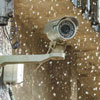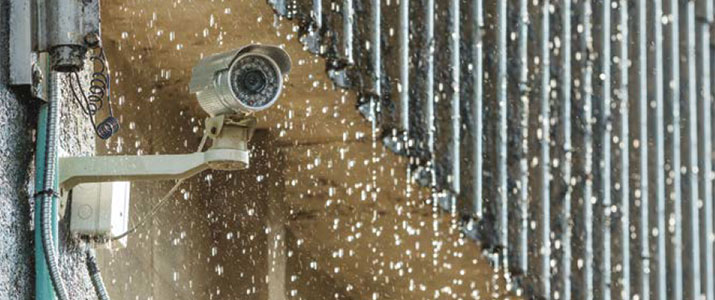
Page 2 of 3
Weatherproof Your Equipment
 The days of security systems guarding primarily against theft, vandalism
and violence are long gone; instead, camera systems are mostly
to protect companies against liabilities such as accidents and negligence.
Another major change in the last decade has been the advent
of weatherproof security solutions. These types of solutions have
been a game changer, shifting the balance of high-quality systems installable from
only indoors to include outdoors.
The days of security systems guarding primarily against theft, vandalism
and violence are long gone; instead, camera systems are mostly
to protect companies against liabilities such as accidents and negligence.
Another major change in the last decade has been the advent
of weatherproof security solutions. These types of solutions have
been a game changer, shifting the balance of high-quality systems installable from
only indoors to include outdoors.
The jumps in technology also greatly increased the range available for wireless
IP cameras. Applications for the weatherproof security systems include, but are
not limited to: neighborhood security, airports, construction sites, golf courses,
theme parks, auto dealerships and outdoor sales areas.
A prime example of a superior weatherproof system application is for a local
automobile dealership. Suppose they have an interior NVR and 32 IP cameras that
are split between the interior sales floor and the exterior car lot. The exterior cameras
can now be either hardwired or wirelessly mounted in additional buildings, on
light poles or even across the street from the main structure and video recorder.
When planning your new system, there are many things that must be considered
prior to making a purchase:
- How large is your project scope?
- Can I go wireless or do I need hard wire back?
- What components make up a full weatherproof system?
- Do I need additional temperature control?
- What kind of enclosure do I need?
- How much support will I get?
Focusing on the Video Recorder
The brain behind your system, be it a simple, four-camera outfit or a complex,
64-camera set-up, is the video recorder that is available in three options. The two
most common are a DVR for recording over coax or fiber—currently the most
popular—and the NVR for recording over IP. The third option is a combination
of analog cameras and IP-based cameras called either a “hybrid DVR” or “hybrid
NVR,” depending on what company it is purchased from. This type of recorder
allows cameras to be hardwired into BNC ports while also accepting cameras from
remote or wireless locations via IP addresses.
That being said, video recorders are not created equal. The most important
specs to review when considering your purchase are: the number of cameras supported;
frames per second (fps); compression record resolutions (CIF, D1, 1MP,
2MP, etc.); hard drive space; network connection/remote viewing capabilities; motion
detection; scheduling; and the ability to save video and audio to a CD or flash
drive for back up. The central monitoring software (CMS) should be intuitive, and
easy to navigate and operate.
Never underestimate the recording and playback strengths when it comes to
frames per second. Traditional movies seen in a theater are typically filmed at 24
fps, but if you’ve seen the recent Hobbit movies, for example, you may have noticed a difference in visual quality and clarity.
Peter Jackson filmed the Hobbit movies
at an astounding 48 fps which makes the
scenes on screen seem hyper-realistic.
The same differences in quality and
clarity apply to cameras and their relationship
to the PC or DVR. Real-time
recording is approximately 30 fps. To
calculate the actual fps-rate a particular
DVR will record, take the total fps
in the system, for instance 960, and divide
it by the number of video inputs,
such as 32, which totals the actual fpsrate
that this DVR will record per camera—
30 fps per camera. Some camera
locations may require higher fps than
others, for example, over a cash register
compared to a hallway, and fps can
typically be adjusted for each camera to
accommodate the specific need(s).
Each video recorder has a specific
storage capacity listed in the specifications
that illustrate how many days of
recording can be stored before the oldest
file is recorded over. This is a rough
estimate that will depend on other factors
such as compression and the type
of cameras connected to the DVR. A
small DVR or NVR can include up to
32 TB while larger, PC-based video recorders
have removable bays for additional
storage capacities, up to 100 TB.
Types of Security Cameras
In addition to determining which type
of video recorder to use, security camera
types vary widely, as well. These
days, cameras can come in any combination
of indoor, outdoor, infrared,
varifocal, fixed, day/night, vandal
proof, PTZ and HD, to name a few.
One of the most important things to
note, however, is whether the cameras
are IP, wireless, HD or analog. Each
camera type has its own specific blend
of components to ensure that all items
will read each other and function correctly.
No matter which method is used
to transmit the data, all cameras will
need a power source.
Most security cameras require two
wires: one for power and one to transmit
the captured video to a display or
recording device, such as TV or DVR.
Depending on the distance from the
DVR for wired cameras, they will need
to run over coax or fiber modem. Wireless
cameras, however, only require one
wire—for power. The video is transmitted
wirelessly via transmitter and receiver
devices, known as access points.
IP cameras will connect to a PoE switch
for power, which will then, in turn, be
connected to both a power source and
a wireless access point transmitter. The
transmitter then sends the compressed
data up to 1.5 miles to the wireless receiver
that relays all data to either a
NVR or hybrid video recorder.
If the camera system is wireless, Wi-
Fi access will be necessary to transmit
the information to the DVR/NVR.
Wireless IP camera systems, hooked to
an NVR, offer the most security and
the longest range in distance between
camera and recorder.
There are several options when it
comes to extending the life of cameras
located outside: special mounting
brackets and housings to protect the
camera or weatherproof cameras with
an IP rating. The IP rating determines
how well the camera itself stands up to the elements. The first digit in the rating
refers to the dust, while the second
refers to how waterproof it is. A ‘5’
is moderate where as a ‘6’ means it is
dustproof or waterproof.
Choosing the Best
Weatherproof Enclosure
Now that the scope of your project has
been determined, you will need to determine
which weatherproof enclosure
best fits your needs. These enclosures
will house power sources, network PoE
switches, wireless access points and anything
else that may need to be installed
outdoors, near the cameras while providing
protection from the elements.
Outdoor, weatherproof enclosures
come in a variety of ratings from the
National Electrical Manufacturers
Association that determine how well
equipment holds up when exposed to
the elements. The most common ratings
in the security field are NEMA3, meaning
that the box is weather-resistant
and protects against weather hazards
such as rain and sleet, and NEMA4,
rating the enclosure as watertight.
The material that the enclosure is
manufactured from matters for both
durability and electronics protection.
Marine-grade 5052 aluminum is far superior
to other materials, such as stainless
steel or plain steel, when it comes
to corrosion resistance and keeping the
interior naturally cooler.
Many times enclosures will require
additional hardware to complete the
installation. Additional considerations
for weatherproof enclosures are:
- What other accessories does the outdoor,
weatherproof enclosure come
with?
- Is the equipment mounting plate adjustable
and removable, and does it
come standard?
- Does it have a sun shade, vents, fans
and/or insulation for additional
temperature control?
- What about brackets for mounting the
box to either a flat surface or a pole?
- Does the enclosure come with a security
lock or is that an add-on item?
Make sure that you have permission
to mount the box. If you are planning
on using an existing pole, check with
the landlord or city. If you do not have
the appropriate permissions, the equipment
may be removed or you could be
fined for property damage. Another factor
is how high to mount the enclosure.
Determine how often the equipment
will need to be accessed and whether or
not it’s in a location that makes it easily
serviceable.
Basic planning ahead will eliminate
99 percent of last minute, on-the-job
headaches that can come with installing
an outdoor, weatherproof system.
Talk to an industry expert, such as
Optiview, when planning and executing
an outdoor, weatherproof, IP surveillance
system. These men and women
can walk you through all of the variables,
step-by-step, to come up with a
custom design for your project. This will
ensure that you get the
best system at the best
price possible.
This article originally appeared in the August 2014 issue of Security Today.